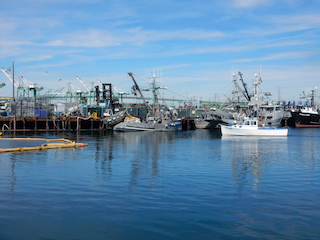
-
| 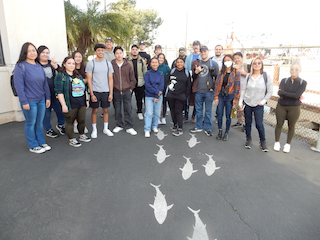
-
| 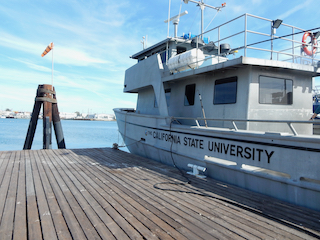
-
|

-
| 
-
| 
-
|
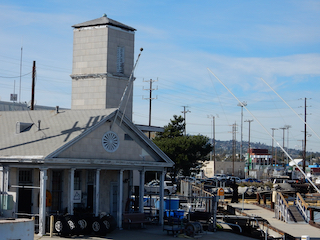
-
| 
-
| 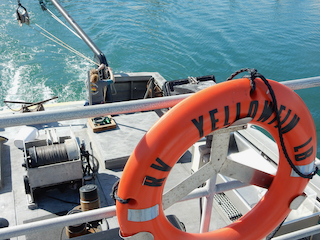
-
|
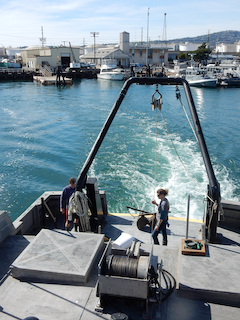
-
| 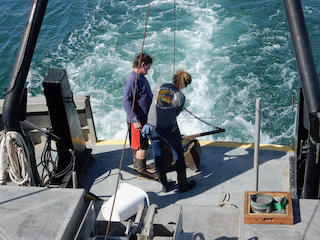
-
| 
-
|
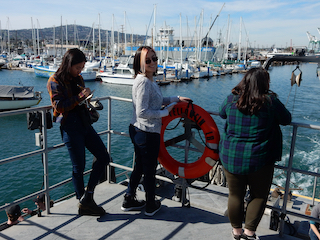
-
| 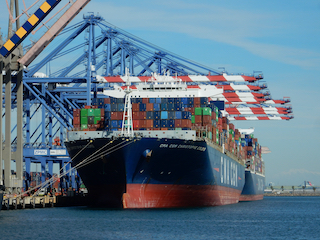
-
| 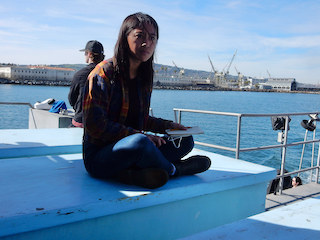
-
|

-
| 
-
| 
-
|

-
| 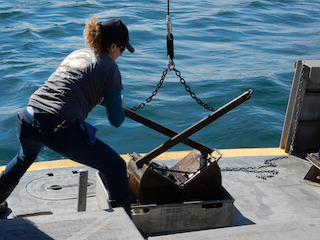
-
| 
-
|
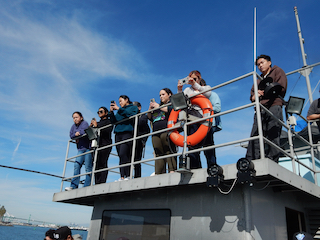
-
| 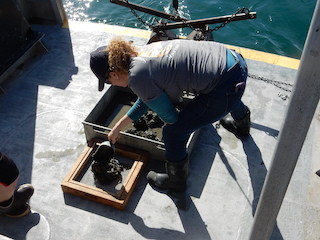
-
| 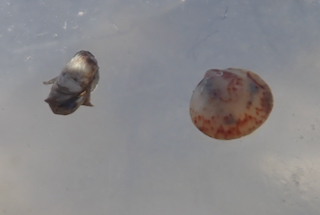
-
|

-
| 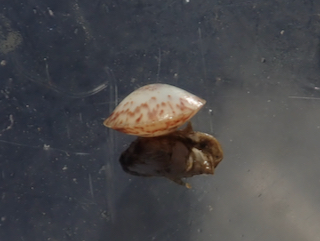
-
| 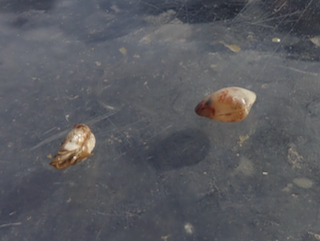
-
|

-
| 
flabelligerid polychaete
| 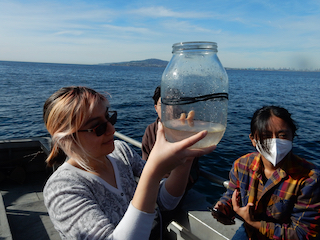
-
|
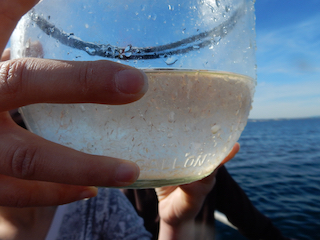
Our zooplankton tow collection was unusually loaded with ctenophores (comb jellies)
besides the usual copepods, etc.
| 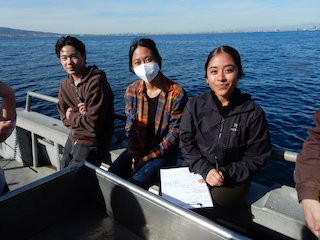
-
| 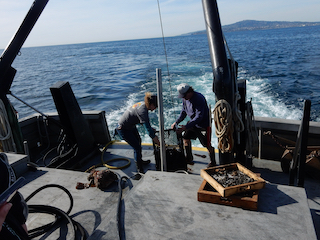
-
|
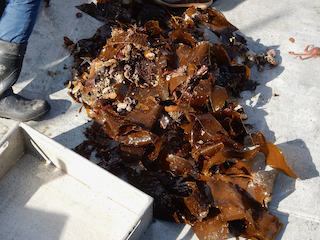
-
| 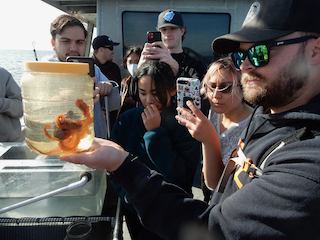
The red octopus (Octopus rubescens) was described in 1953 by S. Stillman Berry.
| 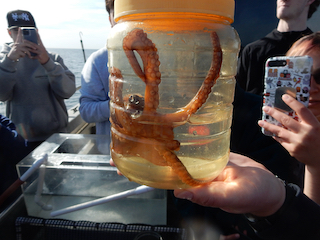
-
|
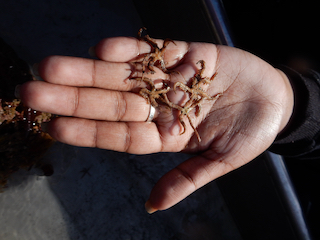
We saw lots of spiny brittlestars (Ophiothrix spiculata).
| 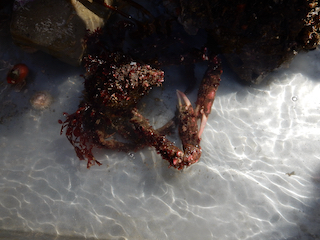
-
| 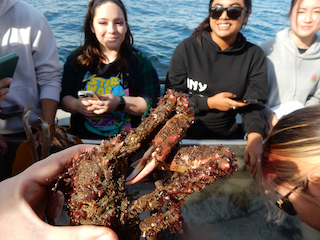
We found two juvenile sheep crabs (Loxorhynchus grandis) that were well decorated.
See below.
|
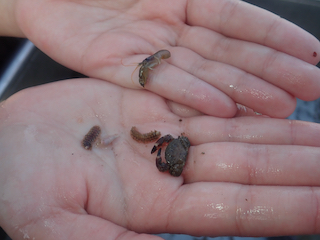
-
| 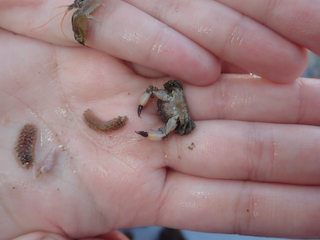
Based on a previous identification kindly provided in 2017 by Leslie Harris, the polychaete
scale worm (Polynoidae) is likely Thormora johnstoni (confirmed by LH from image 2023).
| 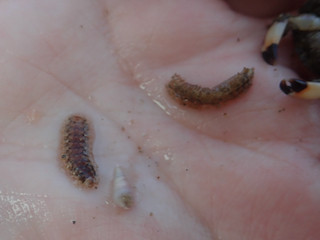
-
|

In 2017, Kathy Ann Miller kindly
identified and provided the following details for a quite similar specimen:
Codium hubbsii is typically subtidal and prostrate, meaning I assume it spreads out on the substrate. It is not especially closely related to the similar appearing,
but more northern and intertidal, C. setchellii. The latter is more irregular and tightly adherent to the substrate, usually in sandy areas, whereas
C. hubbsii tends to be approximately circular, with loose margins.
| 
-
| 
Lepidozona scrobiculata
|

-
| 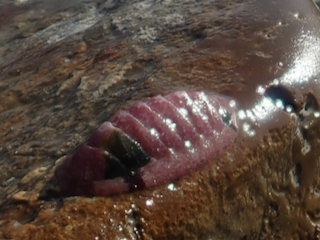
-
| 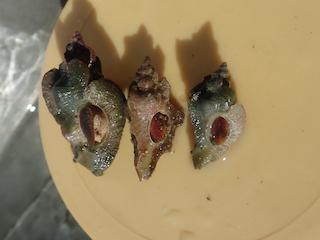
A Pteropurpura vokesae between two P. festiva snails (Neogastropoda: Muricidae).
The P. vokesae was encrusted by multiple bryozoan species, and one tiny pyramidellid ectoparasitic snail. The larger P. festiva had several suspension-feeding
calyptraeid snails, Crepipatella lingulata, whose limpet-like shell is frequently encrusted with an associated orange bryozoan, Rhynchozoon rostratum (earlier similar
bryozoan identification from this depth and locality by Kevin Meade). See below.
|
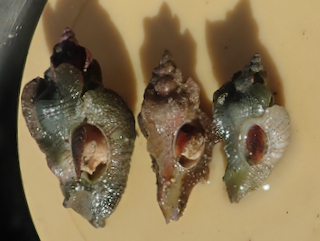
-
| 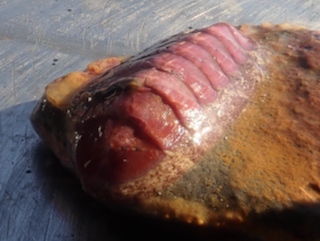
Stenoplax fallax
| 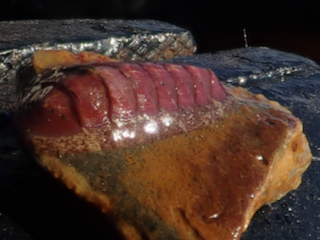
-
|
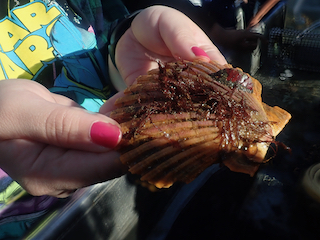
Shell of a San Diego scallop (Leopecten diegensis) that had a chiton attached.
| 
Anthony Draeger and DJE are re-investigating the identity of this chiton species belonging to the genus, Mopalia.
It has been fairly commonly found in the subtidal loose-rock habitat sampled in this and previous cruises at about 25m depth, and also occurs in central California.
In the Light and Smith Manual key of central California to Oregon chitons
(intertidal to scuba depths), we (Eernisse, Clark & Draeger 2007) split a single species into two similar species based on morphological evidence.
In three related publications by Kelly, Eernisse and others
(2007-2008) DNA sequence differences were used to demonstrate substantial genetic separation between these quite similar-appearing species.
In all of these publications, the deeper of two species was tentatively identified as M. acuta, and a previously synonymized name, M. plumosa, was revived for the
shallower species typically found in the intertidal. However, further study of the M. acuta type material by
Draeger and Eernisse (manuscript in prep.) has revealed that we were wrong: M. acuta should instead be the shallower of two species.
Thus, M. acuta has priority as an older name than M. plumosa, and the latter is relegated to become once again a junior synonym of M. acuta.
This required us to check for other potentially available names that might correspond to the deeper species in this image, and we found one that we plan to soon revive.
For now, refer to this one as M. cf. acuta. See here for cited references.
| 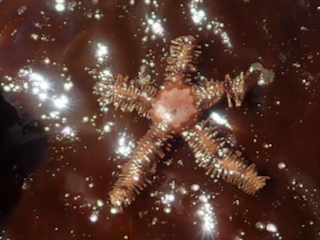
A (beat up) flat-spined Brittle Star, Ophiopteris papillosa.
|
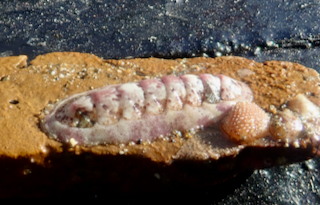
A not-yet-fullgrown chiton, Stenoplax fallax is behind a few suspension-feeding
calyptraeid snails, Crepipatella lingulata, whose limpet-like shell is frequently encrusted with an associated orange bryozoan, Rhynchozoon rostratum (earlier similar
bryozoan identification from this depth and locality by Kevin Meade).
| 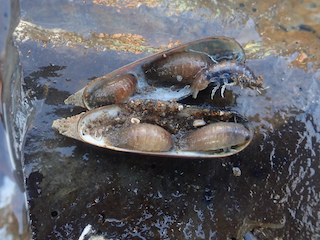
These crustaceans known as isopods were found inside a pair of shells from a deceased date mussel (Leiosolenus plumula) that were still inside the burrow
produced earlier by the mussel, inside subtidal mudstone rocks. They have a similar appearance to the isopods found as ectoparasites on fish, but I presume these are not the same.
| 
-
|

There were two very large Norrisia norrisii (Norris's top snails) whose shells were eroded
down to the (pearly) nacreous layer.
| 
-
| 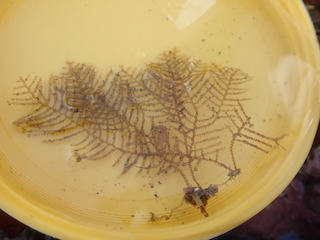
-
|
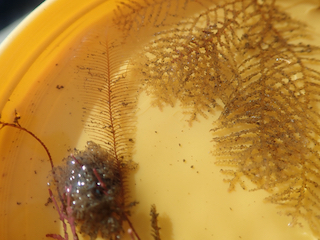
Two unidentified hydroid species.
| 
A juvenile abalone, tentatively identified as a Haliotis fulgens (green abalone).
| 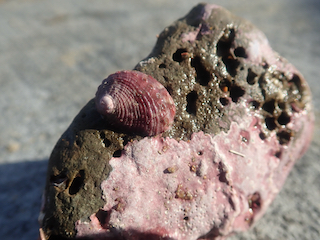
-
|
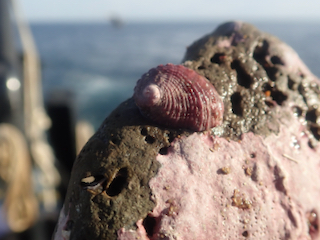
-
| 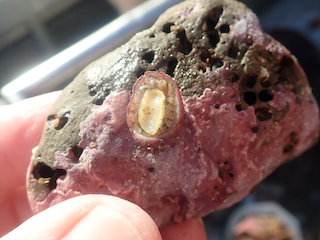
-
| 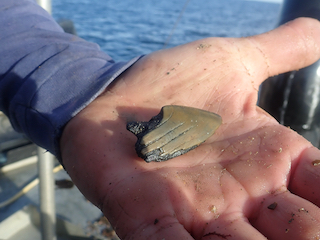
A fossil fragment of a large shark tooth (found by Dennis).
|

-
| 
The clam on the right with an inflated shape is what is currently considered to be a circumboreal species in the family
Lasaeidae, Kellia suborbicularis.
This was first described from the North Atlantic, and it is one of many such cases where further study of a reportedly widespread marine species could reveal them instead to be a complex of two or more species.
I have heard these called the "beer bottle clams" because they are nestlers, living inside (more normally) situations
such as inside this vacated date mussel burrow. Diarmaid O'Foighil (University of Michigan) has reported that dwarf males can be found inside the female's infrabranchial
chamber (from 1993 letter cited in Coan, Valentich-Scott, and Barnard's (2000) book, Bivalve Seashells of Western North America, Santa Barbara Museum of
Natural History). None were observed inside this clam.
| 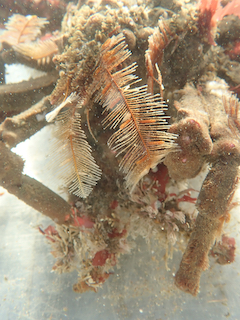
The smaller of two juvenile sheep crabs was quite decorated with hydroid colonies that closely resemble
Aglaophenia latirostris (ostrich-plume hydroid). However, this species was only reported (Haderlie et al. in Morris, Abbott and Haderlie, 1980) as far south
as Santa Barbara, and this sheep crab juvenile was dredged off San Pedro in southern California. More research is needed to either confirm this more southern occurrence
or identify it as something else, perhaps a different Aglaophenia sp.
|
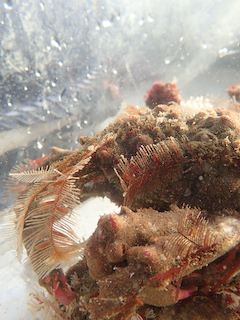
-
| 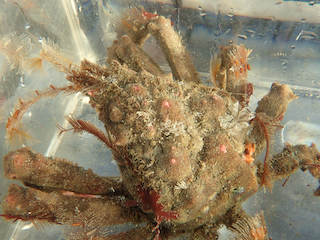
-
| 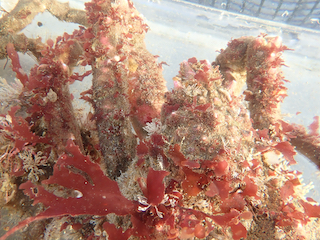
-
|
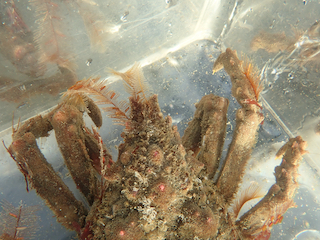
-
| 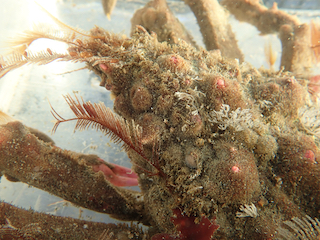
-
| 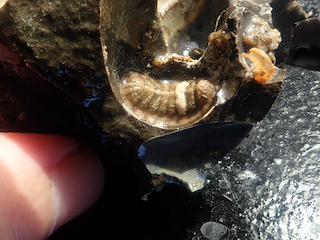
-
|
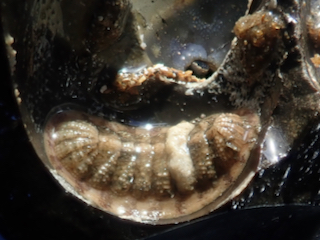
The chiton, Callistochiton palmulatus, in its element, living inside a soft
mudstone rock inside a date mussel burrow. I split open the rock with a hammer and chisel. Note that the chiton's eight valves (or shell plates) are very heavily sculptured with ribbing.
The posterior or tail valve is especially thickened in this species, and because of this is preserved much more often as fossils than the other seven valves.
Judging from fossils at the Natural History Museum of Los Angeles County studied by Vendrasco et al. (2012), the thick tail valves from this species were by far the most commonly preserved
chiton valves of any species in the late Pliocene San Diego Formation (ca. 3 MYBP).
See Vendrasco et al. (2012).
| 
-
| 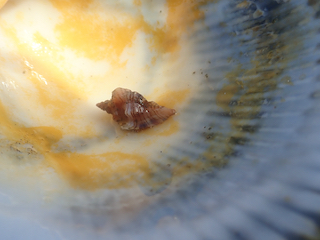
Juvenile festive murex (Pteropurpura festiva), found on the inside of this cockle shell.
|
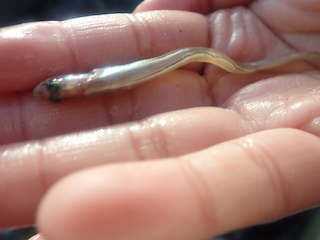
-
| 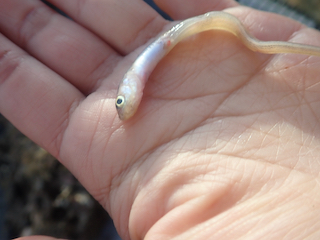
-
| 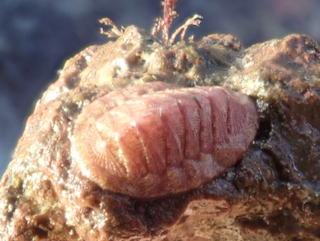
Lepidozona scrobiculata
|

Mopalia cf. acuta (see above).
|
 Under Construction!
Under Construction! Under Construction!
Under Construction!